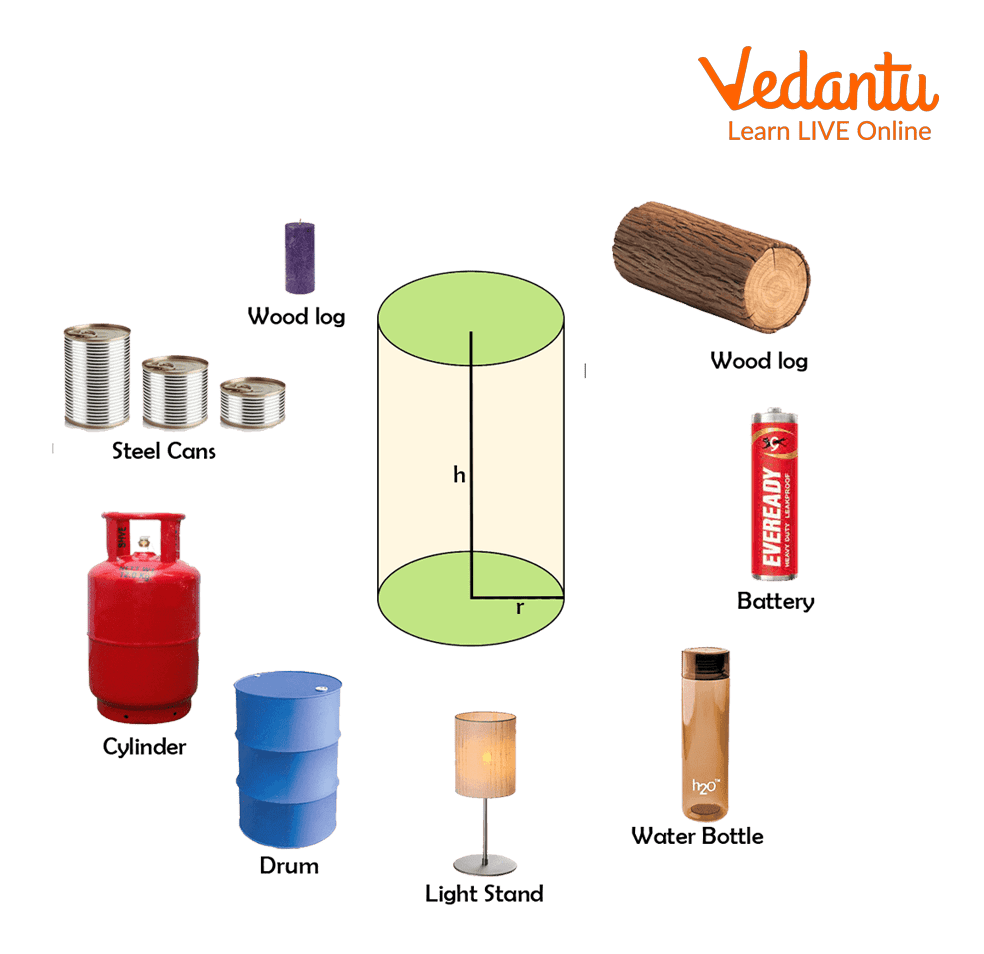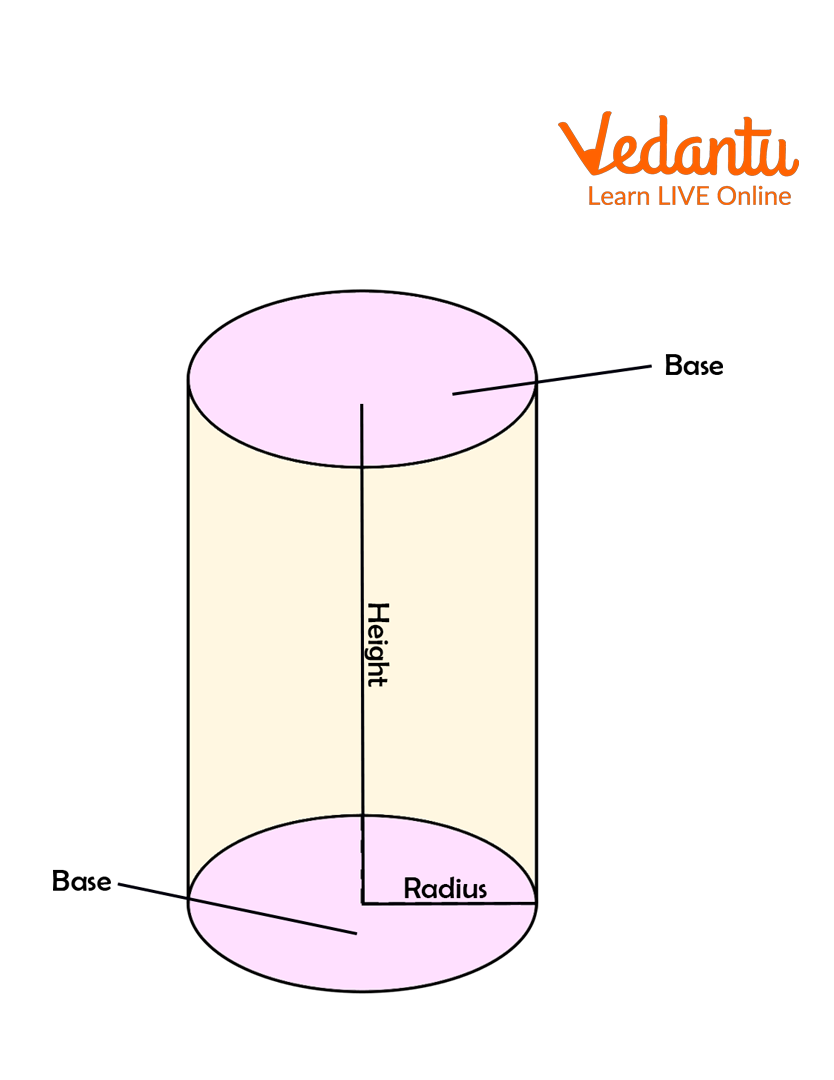




Step-by-Step Guide to Solving Right Circular Cylinder Questions
In this article, we'll learn all about cylinders, which are among the most common three-dimensional shapes we encounter in our daily lives. A cylinder is quite a popular geometrical shape. It is the foundation of many interesting everyday products, such as a can, gas cylinders, rollers, tube lights, chalk, pipe, batteries, cylindrical tumblers/flask, drums, and so on. These solids have circular shape bases that are congruent and parallel. Can you find any cylindrical shapes in your surroundings?

Cylindrical Shapes
What is the Right-Circular Cylinder?
A right-circular cylinder can be defined as a three-dimensional solid geometrical figure of two parallel circular shapes joined by a curved surface. The ends of the right circular cylinder are closed circles and are congruent and parallel to one another. The right cylinder is another name for a right circular cylinder.

Cylinder
Parts of Cylinder
Base: It refers to each of a right circular cylinder's circular ends.
Axis: It refers to the line segment that connects the centres of two circular bases and is perpendicular to the base of the right circular cylinder.
Radius (r): It refers to the circular base's radius.
Height (h): It refers to the length of the cylinder's axis.
Properties of the Right-Circular Cylinder
Some properties of the right-circular cylinder are:
There are two edges present in a right circular cylinder.
The right cylinders have no corners so zero vertices are present.
Cylindrical bases are always parallel to one another.
The shape we obtain is a circle if a plane cuts the right cylinder horizontally and parallel to the bases.
A right cylinder is created when a rectangle is rotated around one side as the axis of revolution.
Longest diagonal of a cylinder is given by $d^2 = 4 \times r^2 + h^2$
Lateral or Curved Surface Area of the Right-Circular Cylinder
The total area that the figure's curving surfaces cover is known as the CSA. It has a square unit of measurement. The lateral surface of the right circular cylinder is the curved surface that links the two circular shape bases, and its area is given by:
$LSA=(Perimeter\:of\:the\:circular\:ends)\times height(h)$
$\:\:\:=2\pi rh\:sq\:unit$
Total Surface Area of the Right-Circular Cylinder
The total surface area of the right circular cylinder is equal to the sum of the bases of both circles plus the CSA.
$TSA=Lateral\:Surface\:Area+2\times(Area\:of\:the\:circle)$
$\:\:\:=2\pi rh+2\pi r^2$
$\:\:\:=2\pi r(h+r) sq\:unit$
Volume of the Right-Circular Cylinder
The volume of any 3-D solid is the amount of space it can hold. It is measured in cubic units like $cm^3$, $m^3$, etc. Thus, the right-circular cylinder formula for volume is given by: $ Volume=\pi r^2 h$ cubic unit
Solved Examples of Cylinders
Example 1: Find the volume of the right cylinder whose height is 20 cm and radius is 5 cm. Take $\pi$=3.14.
Solution: Given h=20 cm and r=5cm
We know that the volume of the right-circular cylinder is given by:
$Volume =\pi r^2 \mathrm{h}$
$\:\:\:\:\:=3.14\times(5)^2\times20$
$\:\:\:\:\:=1570\:cm^3$
Example 2: The radius and height of a right circular cylinder are given as 2.4 m and 6 m, respectively. Find the lateral and total surface area of the right cylinder. Take $\pi$ = 3.14.
Solution: Given r=2.4 m and h=6m
We know that the lateral or curved surface area of the right-circular cylinder is given by:
$LSA =2\pi \mathrm{r}\mathrm{h}$
$\:\:\:=2\times3.14\times2.4\times6$
$\:\:\:=90.432\:m^2$
Now, for the total surface area;
$T S A =2 \pi r(\mathrm{h}+\mathrm{r}) $
$\:\:\:=2 \times 3.14 \times 2.4(6+2.4)$
$\:\:\:=2 \times 3.14 \times 20.16$
$\:\:\:=126.6048 \mathrm{~m}^2$
Practice on Your Own
Q1. Find the total surface area and volume of the right-circular cylinder whose radius and height are 5 cm and 14.9, respectively. Take $\pi=3.14$.
Q2. Find the radius of the cylinder whose lateral surface area is 5024 $m^2$ and height is 8 m. Take $\pi=3.14$.
Ans1: TSA=624.86 $cm^2$; Volume=1169.65 $cm^3$.
Ans2: 100 m.
Quick Summary
Below is a quick summary on the topic right circular cylinder. For more details, you can access the free resources available on the Vedantu website for the state board, CBSE, ICSE, and competitive examinations.
Conclusion
In this article, we have discussed that a cylinder is a 3-D geometric figure having two parallel circular shapes joined by a curved surface. When the axis is perpendicular to the radius, the cylinder is referred to as a right circular cylinder. The real-life cylinder examples provided in this article will assist you in quickly recognizing the cylindrical shapes that surround us.
FAQs on Right Circular Cylinder: Definition, Properties & Uses
1. What is the precise definition of a right circular cylinder in geometry?
A right circular cylinder is a three-dimensional geometric shape that consists of two parallel and congruent circular bases connected by a curved surface. The defining characteristic is that the line segment joining the centres of the two circular bases, known as the axis, is perpendicular (at a right angle) to the plane of the bases.
2. What are the key properties of a right circular cylinder?
A right circular cylinder has several distinct properties that are important for its identification and in calculations:
It has three faces: two flat circular faces (the bases) and one curved lateral face.
It has two curved edges where the lateral surface meets the bases.
It has zero vertices (corners), as the edges are curved and do not meet at a point.
The two circular bases are always parallel and congruent (identical in size and shape).
The axis is always perpendicular to the bases.
3. What are the essential formulas for calculating the volume and surface area of a right circular cylinder?
The primary formulas for a right circular cylinder with radius 'r' and height 'h' are:
Volume (V): The space occupied by the cylinder is calculated as V = πr²h.
Curved Surface Area (CSA) or Lateral Surface Area (LSA): This is the area of the curved surface only, calculated as CSA = 2πrh.
Total Surface Area (TSA): This includes the area of the curved surface plus the area of both circular bases, calculated as TSA = 2πrh + 2πr² = 2πr(h + r).
4. Can you provide some real-life examples of a right circular cylinder?
The right circular cylinder is a very common shape found in everyday objects. Some typical examples include:
Food cans and beverage cans
Household batteries (like AA or AAA)
Straight water pipes and tubes
Unsharpened pencils
Straight-sided candles and lipstick tubes
5. What is the main difference between a regular cylinder and a right circular cylinder?
The primary difference lies in the orientation of the axis relative to the bases. In a right circular cylinder, the axis is perpendicular (forms a 90° angle) to the circular bases. In an oblique cylinder (a type of regular cylinder that is not 'right'), the axis is tilted and is not perpendicular to the bases, giving the shape a slanted appearance.
6. Why is the shape specifically called a 'right' circular cylinder?
The name 'right circular cylinder' precisely describes its geometric properties. The term 'circular' refers to the fact that its bases are circles. The term 'right' indicates that the axis of the cylinder forms a right angle (90°) with its bases. This distinguishes it from oblique cylinders, where this angle is not 90°.
7. How can a right circular cylinder be generated from a two-dimensional shape?
A right circular cylinder can be generated by revolving a rectangle around one of its sides as an axis. When a rectangle is rotated 360 degrees about one of its sides:
The side acting as the axis of rotation becomes the height (h) of the cylinder.
The side parallel to the axis traces the curved surface.
The width of the rectangle (the side perpendicular to the axis) becomes the radius (r) of the circular bases.
8. How do the properties and formulas of a hollow right circular cylinder differ from a solid one?
A hollow right circular cylinder, like a pipe, has an inner and an outer surface. This introduces two radii: an external radius (R) and an internal radius (r). This changes the formulas:
Volume of Material: It is the difference between the outer and inner volumes: V = π(R² - r²)h.
Curved Surface Area: It is the sum of the external and internal curved surface areas: CSA = 2πRh + 2πrh.
Total Surface Area: It includes the CSA plus the area of the two circular 'rings' at the top and bottom: TSA = (2πRh + 2πrh) + 2π(R² - r²).























